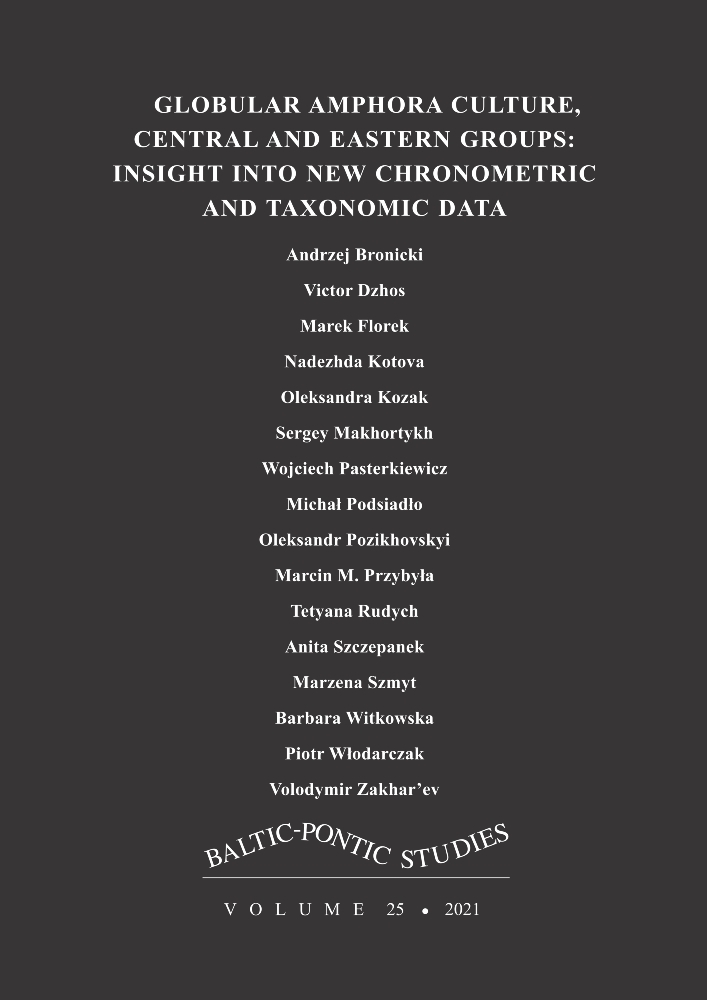Abstrakt
The article presents new radiocarbon datings made for a funeral complex from Malice, site 1, located on the Sandomierz Upland and related to the Globular Amphora culture. The complex included at least two human graves (features no. 32 and 33) and two animal deposits or sacrificial pits (no. 31 and probably 54). Feature 32 was a collective grave including five burials (of a male, a female and three children), while in Feature 33 the only one disarticulated human skeleton has been excavated. Pit 31 contained at least three animal individuals. It is possible the unexamined Pit 54 also contained animal depositions. The described features probably formed two clusters, each of which included a human grave and an accompanying pit with animal deposits. Altogether ten radiocarbon dates were obtained with the dated bone samples coming from five human skeletons found in Graves 32 and 33, and animal remains from Pit 31. The calibration results point to the first half of the 3rd millennium BC and stay between 2909 and 2472 BC (with the probability of 95.4%) or more precisely between 2898 and 2490 BC (probability of 68.2%). However, thanks to the stratigraphic documentation it was possible to determine that five deceased from Feature 32 were buried in three phases most likely to ca. 2850–2750 BC. It is highly probable that individual burials were separated by short time intervals. A similar age should be adopted for Feature 31 – a sacrificial pit linked to Grave 32. However, it is not possible to determine with any certainty the age of Grave 33: it could have been contemporaneous with, or slightly younger (ca 2620–2500 BC) than Feature 32.
Bibliografia
Al Qahtani S. J., Hector M. P., Liversidge H. M. 2010. Brief Communication: The London Atlas of Human Tooth Develompment and Eruption. American Journal of Physical Anthropology 142: 481–490. DOI: https://doi.org/10.1002/ajpa.21258
Balcer B. 1963. Osada kultury amfor kulistych na stanowisku I w Mierzanowicach. Materiały Starożytne 9: 99–142.
Bąbel J. 1979. Groby neolityczne ze stanowiska I w Mierzanowicach, woj. tarnobrzeskie. Wiadomości Archeologiczne 44: 67–82.
Bernert Zs., Évinger S., Hajdu T. 2007. New data on the biological age estimation of children using bone measurements based on historical populations from the Carpathian Basin. Annales Historico-Naturales Musei Nationalis Hungarici 99: 199–206.
Bronicki A. 2016. Obrządek pogrzebowy kultury amfor kulistych na Wyzynie Lubelskiej. In: P. Jarosz, J. Libera, P. Włodarczak (Eds) Schyłek neolitu na Wyżynie Lubelskiej: 45–256. Kraków.
Bronk Ramsey C. 2017. OxCal v4.3.2. Oxford (www. rlaha.ox.ac.uk).
Florek M., Witkowska B. 2021. Absolute chronology of settlement remains of the Globular Amphora culture in Sandomierz Upland (Gałkowice-Ocin, Mierzanowice, Złota-Nad Wawrem). Baltic-Pontic Studies 25: 159–188.
Formicolla V., Franceschi M. 1996. Regression equations for estimating stature from long bones Early Holocene European samples. American Journal of Physical Anthropology 100: 83–88. DOI: https://doi.org/10.1002/(SICI)1096-8644(199605)100:1<83::AID-AJPA8>3.0.CO;2-E
Furholt M. 2003. Die absolutchronologische Datierung der Schnurkeramik in Mitteleuropa und Südskandinavien. Universitätsforschungen zur Prähistorischen Archäologie 101. Bonn.
Geyh M.A. 2001. Bomb radiocarbon dating of animal tissues and hair. Radiocarbon 43: 723–730. DOI: https://doi.org/10.1017/S0033822200041382
Goslar T., Klochko V.I., Kośko A., Włodarczak P., Żurkiewicz D. 2015. Chronometry of late Eneolithic and ‘Early Bronze’ cultures in the middle Dniester area: investigations of the Yampil barrow complex. Baltic-Pontic Studies 20: 256–291. DOI: https://doi.org/10.1515/bps-2017-0006
Kamieńska J. 1959. Osada kultury nadcisańskiej w Malicach, pow. Sandomierz. Materiały Archeologiczne 1: 45–62.
Kamieńska J. 1962. Sprawozdanie z badań osady neolitycznej w Malicach, pow. Sandomierz. Sprawozdania Archeologiczne 14: 52–55.
Kamieńska J. 1963. Sprawozdanie z badań ekspedycji neolitycznej w 1961 r. Sprawozdania Archeologiczne 15: 47–50.
Kamieńska J. 1964. Sprawozdanie z badań archeologicznych na stanowisku neolitycznym w Malicach, pow. Sandomierz w 1962 r. Sprawozdania Archeologiczne 16: 30–34.
Kamieńska J. 1967. Z badań nad kulturą lendzielską w Małopolsce. Archeologia Polski 12(2): 257–279.
Kamieńska J. 1972. Osada neolityczna w Malicach, pow. Sandomierz. Sprawozdania Archeologiczne 24: 327–339.
Krzak Z. 1977. Cmentarzysko na Gajowiźnie pod względem archeologicznym. In: J. Kowalczyk (Ed.) Cmentarzysko kultury amfor kulistych w Złotej Sandomierskiej, 9–79. Warszawa – Kraków – Gdańsk.
Nosek S. 1967. Kultura amfor kulistych w Polsce. Wrocław-Warszawa-Kraków.
Reimer P.J., Bard E., Bayliss A., Beck J.W., Blackwell P.G., Bronk Ramsey C., Buck C.E., Cheng H., Edwards R.L., Friedrich M., Grootes P.M., Guilderson T.P., Haflidason H., Hajdas I., Hatté C., Heaton T.J., Hoffmann D.L., Hogg A.G., Hughen K.A., Kaiser K.F., Kromer B., Manning S.W., Niu M., Reimer R.W., Richards D.A., Scott E.M., Southon J.R., Staff R.A., Turney C.S. M., van der Plicht J. 2013. IntCal13 and Marine13 Radiocarbon Age Calibration Curves 0–50,000 Years cal BP. Radiocarbon 55(4). DOI: https://doi.org/10.2458/azu_js_rc.55.16947
Szmyt M. 1996. Społeczności kultury amfor kulistych na Kujawach. Poznań.
Ścibior J. 1991. Kultura amfor kulistych w środkowowschodniej Polsce. In: J. Gurba (Ed.) Schyłek neolitu i wczesna epoka brązu w Polsce Środkowowschodniej, 47–65. Lublin.
White T., Folkens P. 2005. The Human Bone Manual. Burlington, San Diego. London.
Wiślański T. 1966. Kultura amfor kulistych w Polsce północno-zachodniej. Wrocław – Warszawa– Kraków.
Wiślański T. 1979. Dalszy rozwój ludów neolitycznych. Plemiona amfor kulistych. In: W. Hensel, T. Wiślański (Eds) Prahistoria ziem polskich. II. Neolit, 261–299. Wrocław.
Witkowska B. 2021. Radiocarbon dating of the archival funeral complexes of the GlobularAmphora culture in Sandomierz Upland: sites at Mierzanowice, Sandomierz and Złota-Gajowizna. Baltic-Pontic Studies 25: 7–47.
Witkowska B, Czebreszuk J., Gmińska-Nowak B., Goslar T., Szmyt M., Ważny T. 2020. The cemetery of the Globular Amphora culture community in the Złota-Gajowizna site in the light of radiocarbon analysis and dendrochronology. Sprawozdania Archeologiczne 72(2): 259–284. DOI: https://doi.org/10.23858/SA/72.2020.2.0XX DOI: https://doi.org/10.23858/SA/72.2020.2.2116
Włodarczak P. 2007 Problem chronologii radiowęglowej kultury ceramiki sznurowej w świetle dendrochronologicznych datowań późnoneolitycznych osad palafitowych ze Szwajcarii. Archeologia Polski 52: 35–80.
Włodarczak P. 2019. Grób 15 z Wilczyc na tle środkowoeuropejskim: odmienność i reguław rytuale pogrzebowym małopolskiej kultury ceramiki sznurowej. In: P. Włodarczak (Ed.) Wilczyce, stanowisko 10. Norma i precedens w rytuale pogrzebowym małopolskiej kultury ceramiki sznurowej. Ocalone Dziedzictwo Archeologiczne 9, 169–201. Kraków – Niepołomice – Pękowice. DOI: https://doi.org/10.33547/ODA-SAH.09.Wil
Licencja
Prawa autorskie (c) 2021 Barbara Witkowska, Marcin M. Przybyła, Michał Podsiadło, Anita Szczepanek, Piotr Włodarczak

Utwór dostępny jest na licencji Creative Commons Uznanie autorstwa 4.0 Międzynarodowe.





